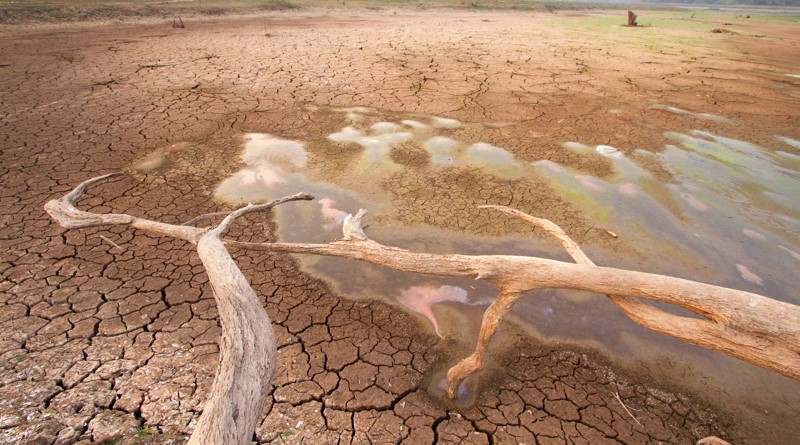Recurrent catastrophies in drought-hit Bundelkhand: New direction needed to tackle the problem

Yogranjan & Deepti Dixit
The Sustainable Development Goals (SDGs) are mandatory benchmarks set by the United Nations, guiding countries to accomplish key objectives by 2030 for a better and more sustainable future1. However, on a wider scale, some countries seem not be able to achieve most of the SDG targets and unfortunately, India is also included in it in real sense, particularly in meeting the goals mentioned as SDG 3 and SDG 6 related to good health and sanitation2.
Here we are quoting the tragic cases of mass infections that have been occurring in the last five years in Tikamgarh, a drought hit district of Bundelkhand zone of Madhya Pradesh in India. Recently, more than 300 people fell sick of diarrhea after drinking contaminated water in village Minaura, located just 5 kilometers away from the district headquarter.
Among the affected, the condition of a pregnant woman became so serious that she had to get admitted in to the Medical College of Sagar which is at a distance of almost 150 kilometers from the village. In another case, in the Nagara village, located about 35 kilometers from the district headquarter, more than 60 children, women, and men fell sick of vomiting and diarrhea after drinking water from a 65-year-old well, out of which a five-year-old child died. This heart-wrenching incident clearly reflects the non-adaptive orientation of ambitious government schemes like Swaksh Bharat Mission and Jal Jeevan Mission at the root level.
The Swaksh Bharat Mission, on one hand aims at bringing behavior change of the masses to adopt better sanitation practices3, while Jal Jeevan Mission envisages to provide safe and adequate drinking water through individual household tap connections by 2024 to all in rural India4. Education and communication are the key components of both the mission. Why the implementation of these schemes started with such momentous objectives is becoming ineffective at root level? This is a big question that must be redressed by diverse organizations working in the area.
Occurrences not the first or out of blue incidents
This is not just the first incident in this area that makes us doubt the successful implementation and adaptation of the schemes, but there have been four such other incidents in some villages within the range of 30-40 kilometers. Recurrences of such incidents in the last five years have emphasized the need for some effective and alternative measures. It also necessitates fixing the accountability of the society and the administration for such contagions occurring due to negligence.
In September 2023, around 56 people have reported to have severe diarrhea and three died after drinking unhygienic water in Amarpur village. This incident had been a media highlight of the country for 2-3 days, but even then no concrete steps were taken towards remedial efforts. Again, August 2022 witnessed an analogous episode in Banagay village in which 19 people got infected with diarrhea and two people lost their lives.
In November 2019, approximately 20 people got affected with diarrhea in Samarra village, merely 18 kilometers from district headquarter. The report of the investigation conducted by the district administration indicated that no concrete steps had been taken for disinfection of water after monsoon. After 2019, such incidents have been reported in year 2022, 2023 and 2024 continuously.
It may be possible that in the year 2020 and 2021, reporting could not have been done amidst the Covid pandemic. However, these frequent incidents obviously oblige us to think that the measures being taken by the government to ensure safe water are completely effective. It cannot be denied at all that there exists a huge gap in the government’s plans and their adaptation. It is not only vital to know who is creating that gap, but there is an earnest need to think and rethink about what kind of efforts can be made to minimize this gap.
Affixing responsibility for this mishap must be the first step
The blow is big and the impact is unpredictable, which can engulf a person of any community, class, creed and age, so obviously it cannot be the responsibility of any one person. If seen with critical angles, everyone in the sphere is directly or indirectly guilty for these accidents, as no one has proper concern for all these incidents besides blaming systems and each other.
It’s quite ironical that everyone starts showing cordiality when such incidents happen, but as soon as the situation comes under control; all the plans and efforts are put to rest. It’s quite ridiculous here that the entire system is immediately set up for the treatment of the affected persons in the incident, but the treatment of infected water, which is the sole cause of these incidents, is widely ignored to a great extent.
No cognizance is taken into what is the cause of contamination and how it can be controlled. This is undoubtedly an aspect to be considered at every level of administration as well as society.
Is the review of situations enough or are some concrete steps required?
Conducting a serious review, forming an investigation committee, submitting the report are the steps taken from the time of an incident till the end of the entire episode. Just making plans out of thin air will do no worthy; instead, the tangible steps need to be strictly followed.
Eradicating diseases caused by contaminated drinking water today is not only vital for public health but also an essential step towards reaching the aspiration of the SDGs. Merely leaving the issues with administrative responsibilities will never work. Bringing together the policy makers, administration, government, cooperative and private institutions along with community participation can only surmount the hurdles.
Developing and implementing emergency response plans for waterborne disease outbreaks can be a must for administration, while engaging the community in water management and decision-making processes to ensure sustainable solutions that meet local needs and preferences must be the on the part of cooperatives and NGOs.
Concerned local authorities must also come forward for required water treatment processes. The administration, in coordination with technical experts, must provide affordable and accessible options for point-of-use water treatment, such as household water filters or chlorine tablets or UV treatments, particularly in areas where centralized treatment or “Nal Jal Yojna” may not be feasible.
Maintenance of infrastructure to prevent leaks, contamination from external sources, and the growth of harmful organisms within the system must be strategized. The extension agencies, religious and social organizations must educate the community for appropriate action.
The universities present in the area should engage their researcher scholars from sciences and social sciences for investigation on the causes, factors and remedial solutions. By implementing a combination of these strategies, these tragic events, which have been happening continuously since 2019, can be almost completely purged.
Authors: Yogranjan is Scientist (Agri-Biotechnology), JNKVV, College of Agriculture, Tikamgarh, Madhya Pradesh (yogranjan@gmail.com); Deepti Dixit is Research Scholar at Maharaja Chhatrasal University, Chhatarpur, Madhya Pradesh.
References:
- Moyer, J. D., & Hedden, S. (2020). Are we on the right path to achieve the sustainable development goals?. World Development, 127, 104749.
- Halkos, G., & Gkampoura, E. C. (2021). Where do we stand on the 17 Sustainable Development Goals? An overview on progress. Economic Analysis and Policy, 70, 94-122.
- VerKuilen, A., Sprouse, L., Beardsley, R., Lebu, S., Salzberg, A., & Manga, M. (2023). Effectiveness of the Swachh Bharat Mission and barriers to ending open defecation in India: a systematic review. Frontiers in Environmental Science, 11, 1141825.
- Joshi, V., & Patel, A. (2024). A Review of Har Ghar Nal Yojana (Jal Jeevan Mission): A Case Study of 10 Villages. International Journal of Innovative Research in Technology and Science, 12(2), 506-511.
(Disclaimer: India Water Review does not take any responsibility for the views expressed in the article. The article published also does not in anyway reflect the opinion of India Water Review.)



